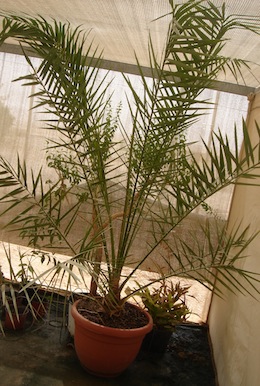The date palm Methuselah “is a big boy now.” (photo from Arava Institute)
When I contacted Dr. Elaine Solowey, a California-born botanist of the Arava Institute for Environmental Studies at Kibbutz Ketura, for an update on the date palm Methuselah, she said, “He is a big boy now. He has flowered several times and his pollen is good. I hope to have some good news about companions for him.”
In honour of Tu b’Shevat in 2011, I wrote about Methuselah for the Jewish Independent and other publications. What best symbolizes the holiday known in the Talmud as Rosh Hashanah l’Ilanot, the New Year of the Trees, more than dates?
For that 2011 article, I interviewed London-born Dr. Sarah Sallon, director of the Louis Borick Natural Medicine Research Centre at Hadassah Medical Centre in Jerusalem, who is friends and colleagues with Solowey.
Sallon said that, in 2005, “we were interested in rejuvenating lost flora of Eretz Yisrael,” including the Judaean date. During a conversation with scientists about extracting DNA from ancient seeds, she wondered about the possibility of growing such seeds, and Masada came up.
In the early 1960s, during excavations of Masada – the fortress built by King Herod more than 2,000 years ago – archeologists Yigal Yadin and Ehud Netzer found date palm seeds. Under the custodianship of Netzer, the seeds were stored at Bar Ilan University in Tel Aviv.
At the Louis Borick Centre, Sallon directs research on complementary alternative and integrated medicine through the Middle Eastern Medicinal Plant Project. After studying medicines of Tibet, as an introduction to the ancient world of traditional medicine, the centre began to look at the medicinal plants of Eretz Yisrael, of which there are approximately 2,900 species. Sallon asked Netzer if she and her researchers could have a few seeds, and they were given five palm seeds, which Sallon took to Solowey.

Solowey took three of the ancient seeds and planted them in January 2005. Other seeds were sent to the University of Zurich, Switzerland, for radiocarbon dating and other testing. The date palm, which can be male or female, was domesticated more than 6,000 years ago, and is used for lung disease, colds, heart disease, hair growth and other things.
After eight weeks, in March 2005, one seed successfully germinated and was named Methuselah, after the biblical person who was said to have lived 969 years. Initially, the leaves had white spots because of a lack of chlorophyll. At 15 months, the seedling was transferred to a larger pot. After 26 months, the plant showed normal development, and Sallon said Methuselah is accepted by Guinness World Records as the oldest seed cultivated.
In 2011, I saw a photograph of Methuselah on a computer when its location was secret. At that time, it was two metres high (about six-and-a-half feet) and in a “protected quarantine site,” due to its scientific and financial value. In April of that year, a white flower appeared on the inner part of the tree, indicating that Methuselah was a male date palm. And, on Nov. 24, 2011, Methuselah was planted at Kibbutz Ketura.
Today, Methuselah has a permanent home at the Arava Institute research park on Kibbutz Ketura. As I wrote this update, there was hope for Methuselah to be bred with a female tree to produce the same date variety eaten commonly in ancient Judea, where it was valued as much for its flavour as for its medicinal properties.
Solowey continues to work with palms and has grown other date palms from ancient seeds found in archeological sites around the Dead Sea, as well.
“I’m trying to figure out how to plant an ancient date grove,” she said. And, if she can succeed in bringing forth a modern grove of ancient trees, it would provide unique insight into history. “We would know what kind of dates they ate in those days and what they were like,” she said. “That would be very exciting.”
Sybil Kaplan is a journalist, lecturer, book reviewer and food writer in Jerusalem. She created and leads the weekly English-language Shuk Walks in Machane Yehuda, she has compiled and edited nine kosher cookbooks, and is the author of Witness to History: Ten Years as a Woman Journalist in Israel.

